Artifact 5: Module 4
During module 4, I learned about the misrepresentation of data, the media’s ability to distort facts, and how fear affects personal judgment and decision making. In Are We Scaring Ourselves To Death?, fear is discussed as a factor that directly influences the decisions people make. The media uses its ability to distort or misrepresent facts as a scare tactic to watch their programming. Throughout this video, I came to the conclusion that I have also altered my decision making due to fear. I have maintained that it isn’t as safe to be out after dark and there are certain neighborhoods that may be more dangerous than others, because of the media’s consistent reports on crimes happening in these scenarios. Even the ability to recall tragic events affects decision making, regardless of the factual data that supports the incidents are not likely to happen.
I enjoyed this module’s item to archive a lot because it enabled me to reevaluate what I view as a credible source. I have grown up viewing my parents watch the news, therefore I always viewed the news as the “end all, be all” on facts. Further understanding on how the media can manipulate certain emotions, such as fear, allowed me to reshape the lens from which I view media coverage. Emotions can overcome rationale, which made me reconsider the processes I use to make decisions and judgments. This module’s item to archive encouraged me to become a more skeptical and acutely aware consumer of media.
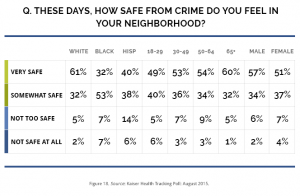
I chose this table for my representative visual image because it shows the differences in opinion on how safe community members feel within their neighborhoods. As I discussed above, fear, especially when manipulated by the media, can lead to judgments and skewed perceptions on feelings of safety.
Artifact 4: Module 8
The activity in this module required using opinion to label stereotypic words to different racial and ethnic groups. While labeling each group with adjectives, I acknowledged the words I chose stemmed from my own personal experiences or preconceived opinions from others I had adopted as my own. This activity made me more aware of my own prejudices as well as how I view the group I believe myself to belong to. I enjoyed this item to archive because I would not have seen how I judged certain groups of people previously.
This item to archive was especially poignant during this current time in history. Many people of different racial and ethnic groups are still currently being persecuted due to stereotypes. This activity was meaningful to me because I genuinely felt compassion and empathy for the different demographics that experience these harsh stereotypes on a regular basis.
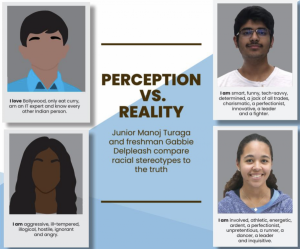
My representative visual image illustrates how men and women of different racial and ethnic groups are misjudged. The boy and girl in this picture personally describe themselves with drastically different adjectives than what society’s incorrect stereotype has labeled them.
Artifact 3: Module 7
Completing the behavior and attitudes survey opened my eyes to my own authenticity. This item to archive is one of my top 5 because it made me aware of how my behaviors and beliefs had become unaligned. As discussed in the activity, my religious beliefs and actions became disjointed. I was proclaiming myself to be a devout Catholic but had stopped attending mass, didn’t proclaim my faith in my everyday life, and wasn’t living as a well-rounded member of the Catholic Church. I didn’t like the feeling of dissonance or overwhelming lack of comfort I experienced when realizing I wasn’t being authentic. This item to archive sprung me into action. I was able to assuage my feelings by starting to pray again and regularly attending mass. In doing so, I realigned my behaviors with my beliefs. I reflected on the behaviors and attitudes surveys and acknowledged that I want to always do as I say and act on that philosophy. This was one of my favorite items to archive because of its personal relevance to me.
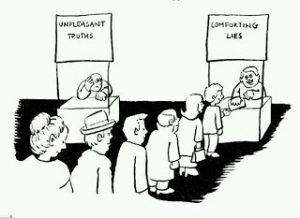
My representative visual image depicts how dissonance exists when behavior and attitudes are mismatched. As seen in this picture, people are forming a line as they gravitate toward comforting lies, a metaphor for their beliefs supporting their behaviors, versus unpleasant truths which is a metaphor for the reality that their beliefs and behaviors are misaligned.
Artifact 2: Module 3
This item to archive was interesting to me because of its relevance to my personal life. I find that I am more interested in topics that I can apply to myself or hold some personal relevance to me. This activity included comparing two philosophies on relationship compatibility. My fiancé conveniently agreed on the philosophy, “like attracts like”. Him and I both agreed that when two members of a couple are similar in their beliefs, values, approach to situations, and overall nature– that couple is successful. My mother and father on the other hand have successfully accomplished 25 years of being happily married and they both believe in the “opposites attract” philosophy.
I enjoyed this item to archive so much so that I included it in my top 5 artifacts. This item to archive enabled me to analyze my own view while being able to understand the viewpoint of others close to me. This topic lead to deeper discussion between my fiancé and I as well as between my parents and I. Aside from this item to archive’s personal relevance to me, this activity delved into how there are many perceptions that exist and how all of them can be successful in their own way.
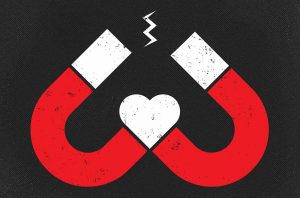
I chose this picture as my representative visual image because it showcases how opposites attract. Either end of a magnet possess opposite charges which repel each other. However, as seen in this image, as well in real-life relationships, opposites can attract each other. To me, this image showcases the “opposites attract” philosophy in a way that is easy to visualize.
Artifact 1: Module 6
This item to archive made it into my top 5 artifacts because I was able to view myself from a more objective viewpoint. I picked traits about myself, both positive and negative, that I felt truly encompassed who I am as a person. In doing this activity, I felt a feeling of pride about the traits I possessed. Many people experience a lack of self-love and self-worth, including myself, so to be able to acknowledge traits about me I was proud of boosted the image I have of myself. Especially after being a victim of an abusive relationship, this activity reminded me that there are qualities about me that are worth appreciating and loving. This item to archive is one of my top artifacts because like the other items to archive previously discussed, this activity was able to teach me new lessons while being personally relevant to my own life and experiences.
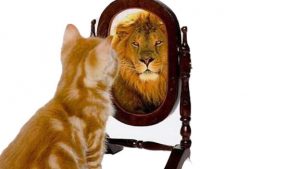
This picture is my representative self image because of its direct relation to self-perception. This picture shows how self-perception, such as a cat viewing itself as a lion, can potentially change one’s attitudes, behaviors, and obviously self-image. When people view themselves in a favorable light, I believe they are happier and more accomplished individuals.